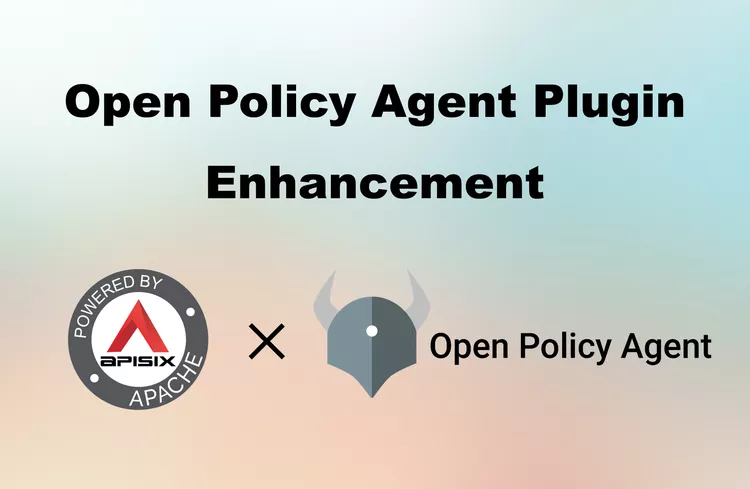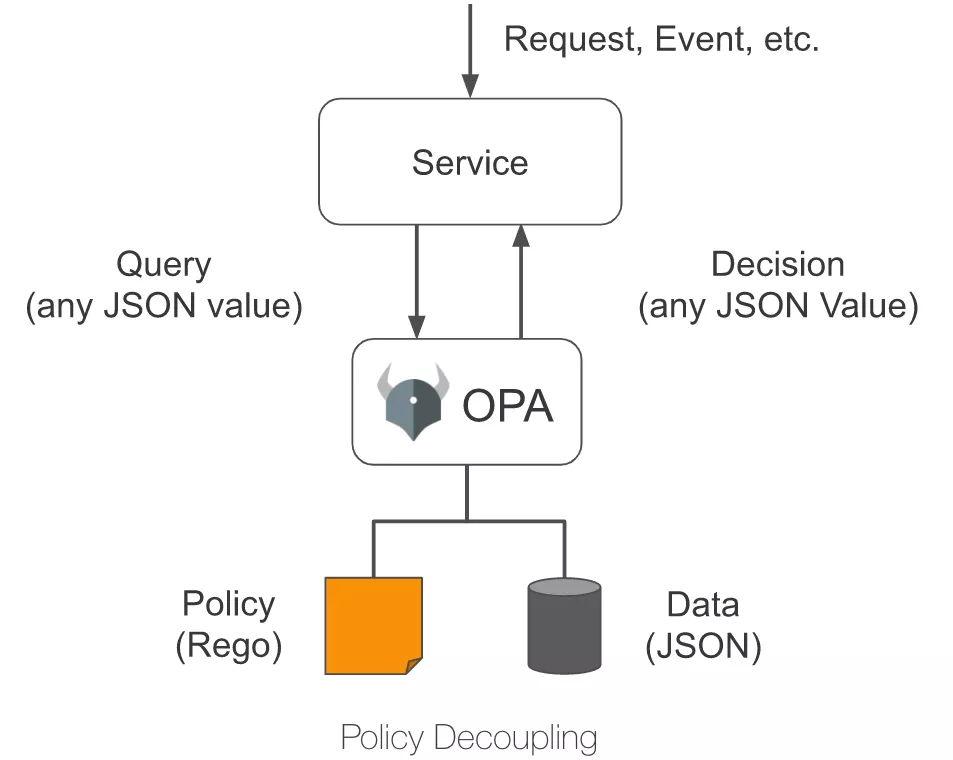This article introduces the
opaplug-in as an example of HTTP API and details how to integrate Apache APISIX with OPA to decouple the authentication authorization of back-end services.

Open Policy Agent (OPA) is an open source lightweight general-purpose policy engine that can replace the built-in policy function module in software and help users decouple services from the policy engine. Thanks to OPA's well-established ecosystem, users can easily integrate OPA with other services, such as program libraries, HTTP APIs, etc.
As shown in the figure below, OPA first describes the policy through the policy language Rego; then stores the policy data through JSON, after which the user can send a query request. After receiving the query request, OPA will combine the policy, data and user input to generate a policy decision and send the decision to the service.

Plugin Introduction
Apache APISIX provides an opa plug-in that allows users to conveniently introduce the policy capabilities provided by OPA to Apache APISIX to enable flexible authentication and access control features.
After configuring the opa plug-in on a route, Apache APISIX assembles request information, connection information, etc. into JSON data and sends it to the policy decision API address when processing response requests. As long as the policy deployed in OPA conforms to the data specification set by Apache APISIX, functions such as pass request, reject request, custom status code, custom response header, custom response header, etc. can be implemented.
This article takes HTTP API as an example to introduce the opa plug-in and details how to integrate Apache APISIX with OPA to decouple authentication authorization for back-end services.
How to use
Build test environment
Use Docker to build OPA services.
# Running OPA with Docker
docker run -d --name opa -p 8181:8181 openpolicyagent/opa:0.35.0 run -sCreate an
examplepolicy.# Create policy
curl -XPUT 'localhost:8181/v1/policies/example' \
--header 'Content-Type: text/plain' \
--data-raw 'package example
import input.request
import data.users
default allow = false
allow {
# has the name test-header with the value only-for-test request header
request.headers["test-header"] == "only-for-test"
# The request method is GET
request.method == "GET"
# The request path starts with /get
startswith(request.path, "/get")
# GET parameter test exists and is not equal to abcd
request.query["test"] != "abcd"
# GET parameter user exists
request.query["user"]
}
reason = users[request.query["user"]].reason {
not allow
request.query["user"]
}
headers = users[request.query["user"]].headers {
not allow
request.query["user"]
}
status_code = users[request.query["user"]].status_code {
not allow
request.query["user"]
}'Create
usersdata.# Create test user data
curl -XPUT 'localhost:8181/v1/data/users' \
--header 'Content-Type: application/json' \
--data-raw '{
"alice": {
"headers": {
"Location": "http://example.com/auth"
},
"status_code": 302
},
"bob": {
"headers": {
"test": "abcd",
"abce": "test"
}
},
"carla": {
"reason": "Give you a string reason"
},
"dylon": {
"headers": {
"Content-Type": "application/json"
},
"reason": {
"code": 40001,
"desc": "Give you a object reason"
}
}
}'
Create a route and enable the plugin
Run the following command to create the route and enable the opa plugin.
curl -XPUT 'http://127.0.0.1:9080/apisix/admin/routes/r1' \
--header 'X-API-KEY: <api-key>' \
--header 'Content-Type: application/json' \
--data-raw '{
"uri": "/*",
"methods": [
"GET",
"POST",
"PUT",
"DELETE"
],
"plugins": {
"opa": {
"host": "http://127.0.0.1:8181",
"policy": "example"
}
},
"upstream": {
"nodes": {
"httpbin.org:80": 1
},
"type": "roundrobin"
}
}'
Test Requests
Next, run the following command to send a request to the opa plugin to test the plugin's running status.
# Allow requests
curl -XGET '127.0.0.1:9080/get?test=none&user=dylon' \
--header 'test-header: only-for-test'
{
"args": {
"test": "abcd1",
"user": "dylon"
},
"headers": {
"Test-Header": "only-for-test",
"with": "more"
},
"origin": "127.0.0.1",
"url": "http://127.0.0.1/get?test=abcd1&user=dylon"
}
# Reject the request and rewrite the status code and response headers
curl -XGET '127.0.0.1:9080/get?test=abcd&user=alice' \
--header 'test-header: only-for-test'
HTTP/1.1 302 Moved Temporarily
Date: Mon, 20 Dec 2021 09:37:35 GMT
Content-Type: text/html
Content-Length: 142
Connection: keep-alive
Location: http://example.com/auth
Server: APISIX/2.11.0
# Rejects the request and returns a custom response header
curl -XGET '127.0.0.1:9080/get?test=abcd&user=bob' \
--header 'test-header: only-for-test'
HTTP/1.1 403 Forbidden
Date: Mon, 20 Dec 2021 09:38:27 GMT
Content-Type: text/html; charset=utf-8
Content-Length: 150
Connection: keep-alive
abce: test
test: abcd
Server: APISIX/2.11.0
# Rejects the request and returns a custom response (string)
curl -XGET '127.0.0.1:9080/get?test=abcd&user=carla' \
--header 'test-header: only-for-test'
HTTP/1.1 403 Forbidden
Date: Mon, 20 Dec 2021 09:38:58 GMT
Content-Type: text/plain; charset=utf-8
Transfer-Encoding: chunked
Connection: keep-alive
Server: APISIX/2.11.0
Give you a string reason
# Rejects the request and returns a custom response (JSON)
curl -XGET '127.0.0.1:9080/get?test=abcd&user=dylon' \
--header 'test-header: only-for-test'
HTTP/1.1 403 Forbidden
Date: Mon, 20 Dec 2021 09:42:12 GMT
Content-Type: application/json
Transfer-Encoding: chunked
Connection: keep-alive
Server: APISIX/2.11.0
{"code":40001,"desc":"Give you a object reason"}
Disable the plugin
Thanks to the dynamic nature of Apache APISIX, the OPA plug-in on a route can be turned off by simply removing the opa plug-in related configuration from the route configuration and saving it.
Summary
This article describes the detailed steps for interfacing Apache APISIX and Open Policy Agent. We hope this article will give you a clearer understanding of using Open Policy Agent in Apache APISIX and facilitate the subsequent hands-on operation.
Apache APISIX is not only committed to maintaining its own high performance, but also has always attached great importance to the construction of open source ecology. At present, Apache APISIX has 10+ authentication authorization-related plug-ins that support interfacing with mainstream authentication authorization services in the industry.
If you have the need to interface with other authentication authorities, visit Apache APISIX's GitHub and leave your suggestions via issue; or subscribe to Apache APISIX's mailing list to express your ideas via email.

